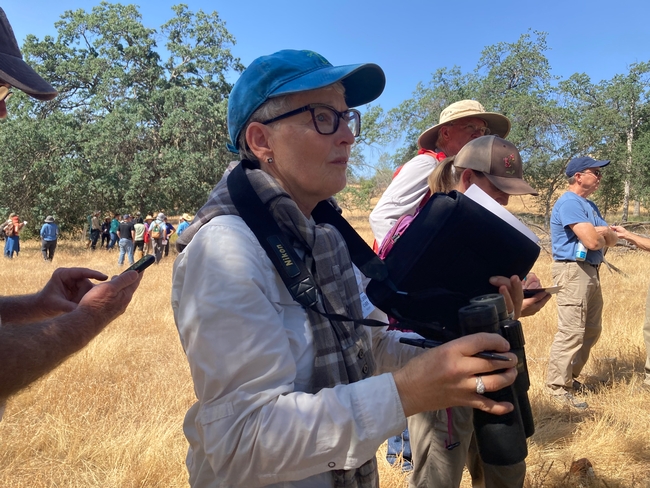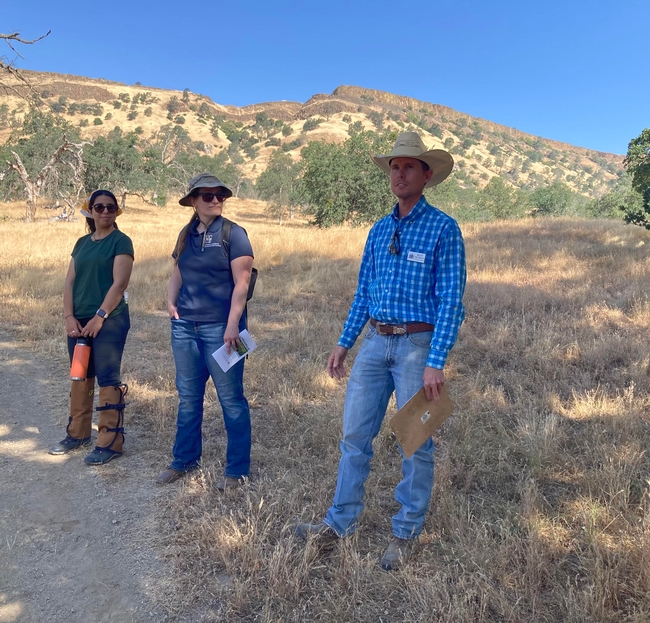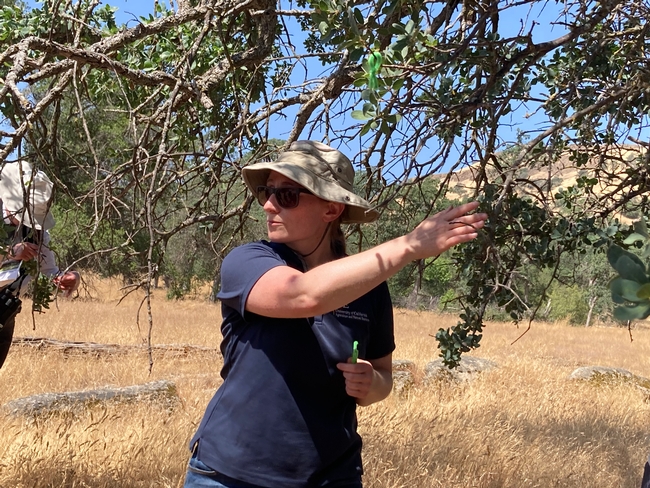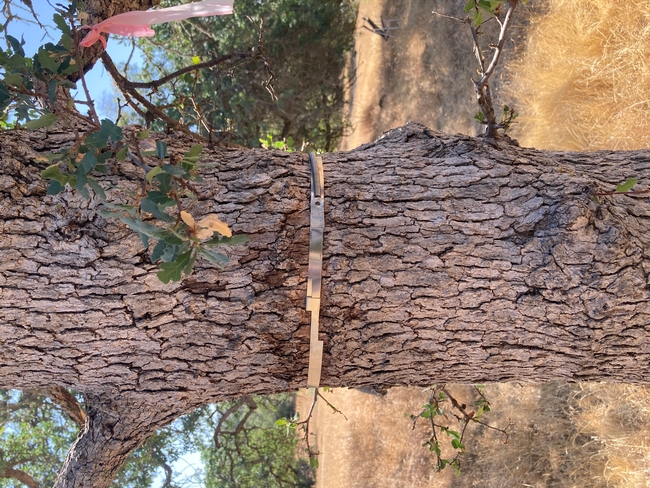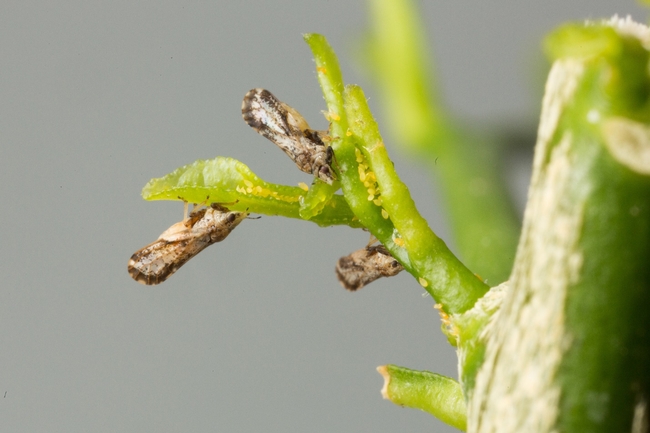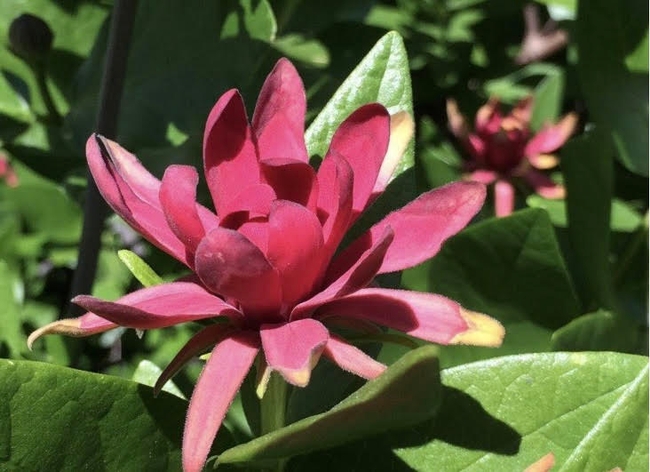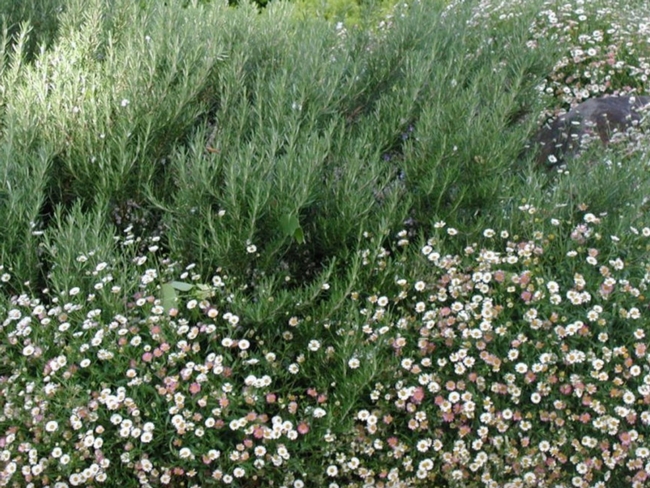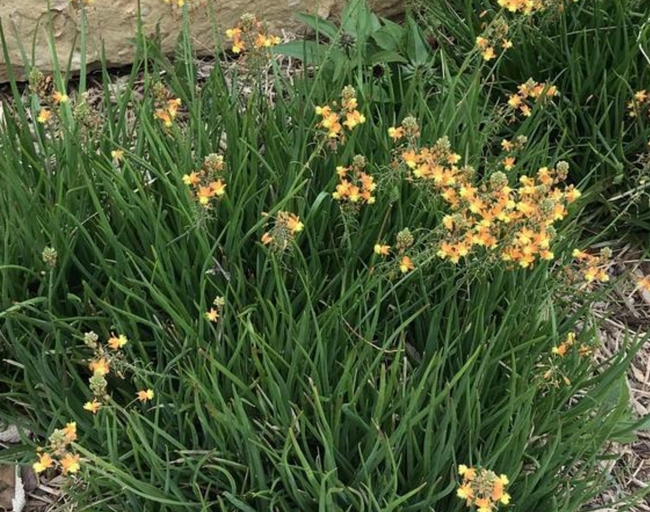- Author: Jeannette Warnert
Beth Linder Carr has lived among blue oaks in Auberry for nearly 35 years. There are dozens on her 10-acre property, but the one in particular she and her husband prize is a majestic specimen in the center of their circular driveway. They were dismayed when two huge limbs crashed down unexpectedly within the last 18 months.
“I thought it might not leaf out at all this year, but it's in full leaf now; its formerly huge canopy now patchy and uneven,” Linder Carr said. “Whether it's just old and dying, or the drought has contributed to its decline — or a combination — is unclear to me.”
Linder Carr brought her questions to a field day June 3 at the McKenzie Preserve near Prather, one of eight preserves owned by the Sierra Foothill Conservancy, where UC Cooperative Extension and other scientists shared early results of ongoing studies of blue oak trees.
Blue oaks are a keystone species in the foothill ecological zone, said Billy Freeman, Sierra Foothill Conservancy rangeland manager. They sequester carbon, provide wildlife habitat, support foothill biodiversity and are beautiful. Research underway at the site will inform landowners about how land management may impact the ecosystem, particularly considering the warming California climate.
The study is divided into two plots: one treated with short term, high density cattle grazing, and the other managed with continuous moderate grazing.
“A few years of monitoring the trees on these sites will help us understand which grazing practices best support blue oaks,” Freeman said.
Sokaina Alkhafaji is recording changes in oaks for the National Ecological Observatory Network. Dendrometers, aluminum bands rigged with small springs, were installed on 30 trees to accurately measure the incremental increase in tree diameter year to year. Each month, researchers visit the plot to document the timing of seasonal changes, such as bud break, leaf emergence, canopy fullness and acorn production.
“Right now, we don't know how oaks are doing. Does grazing management need to be changed? Do we need to cage seedlings?” she said.
The canopy areas and tree trunk diameter are documented in the first year of the study and will be repeated in five to 10 years. She visits the oaks twice a year. In the spring, her study documents tree vigor and mortality and the number of seedlings sprouting beneath tree canopies. In the fall, she counts acorns, measures shoot growth and confirms whether the seedlings found in the spring are still growing.
“Our goal is to monitor the trees at least 10 years in the four places,” she said.
The monitoring protocol is designed to be easy for foothill residents and land managers to replicate. For example, shoot growth is determined by twisting a pipe cleaner on twigs on the north, south, east and west sides of the tree, then returning to those twigs each year to measure new growth. Acorns are estimated by counting acorns in the oak canopy for a set period of time – such as 20 seconds – and then recording the number.
“Our key goal is making monitoring as consistent, time efficient and as cheap as possible,” Ozeran said.
The field day resonated with Linder Carr. As soon as she got home, she said, “I started looking at the trees with new eyes. Our big center oak, for instance, has much bigger girth than any of the trees on the preserve, and so it would be interesting to measure some of ours.”
- Author: Jeannette Warnert
Asian citrus psyllid and the devastating disease it spreads, huanglongbing, are still serious threats to commercial and backyard citrus in Fresno County. The psyllids have been found locally, including an infestation near Orange Cove last year that was treated by the California Department of Food and Agriculture. To date, aggressive efforts by ag officials, farmers, nursery managers and home growers have kept the pest under control and huanglongbing out of Fresno County.
In San Bernardino County, which is generally infested with ACP and where HLB has been detected, every Master Gardener class begins with a five- to seven-minute presentation about ACP/HLB, said MG coordinator Maggie O'Neill.
“We encourage residents to get out in their gardens to check their citrus trees for symptoms and signs of ACP and HLB weekly,” she said. “Besides, spending time in the garden is good for mental and physical health, so it's good for the garden and good for you.”
O'Neill also asks that each member of the audience tell three people, so they can, in turn, tell three more people to regularly check their citrus trees.
“Spread the word, not the pest,” she said.
Scientists believe the Central Valley climate may provide a less hospitable environment for Asian citrus psyllid, but regular monitoring of citrus trees is recommended to help preserve fruitful commercial and home-grown citrus for the future.
Using a hand lens or loop, look closely at the leaves and tender new growth. The ACP adult is the size of an aphid and feeds with its rear end tilted up at a 45-degree angle. Nymphs produce white, waxy tubules and are always found on new leaf growth or young stems. The eggs are yellow-gold and found on the newest leaf growth, nestled among unfolded leaves.
HLB cannot be detected visually until many months after infection. The first symptom is blotchy yellow mottling of leaves that is not the same on both sides of the leaf. This looks different from the typical signs of nutrient deficiency, which causes a similar pattern of yellowing on both sides of the leaf.
Report signs and symptoms of ACP/HLB to the CDFA hotline at (800) 491-1899.
The University of California manages a website for home citrus growers with a map showing areas where Asian citrus psyllid have been found in California and detailed information on options for reducing psyllid populations around your home, such as managing ants, protecting natural enemies and applying insecticides.
- Author: Susan Rosenthal
Calycanthus occidentalis, or western spice bush, is a large deciduous shrub native to lower elevations of the Coast Range, Sierra Nevada and southern Cascades. Reaching 10- to 12-feet tall and wide, it makes an excellent specimen plant or can be limbed up into a small multitrunked tree.
Large leathery leaves have a spicy scent when crushed and turn golden yellow in the fall. Fragrant maroon red flowers, reminiscent of lotus flowers, magnolia blossoms or water lilies, appear in late spring through summer. The distinctive flowers are actually whorls of structures called tepals, or undifferentiated petals and sepals.
Blooms are followed by large fruit capsules that remain through the winter. Spice bush is not fussy about soil type or pH. Naturally found in moist canyons and along streams, this one will look best with regular water. Leaves may burn if it gets too dry. Will take full sun near the coast, but in our area it's best in partial or dappled shade. Prune immediately after flowering to shape and control growth. No known disease or pest issues. Calycanthus occidentalis is yet another UC Davis Arboretum AllStar.
- Author: Susan Rosenthal
It might be tempting to pass on this one, sometimes dismissed as a weed, at the garden center, but that would be a mistake.
Erigeron karvinskianus, or Santa Barbara Daisy, is a tough, almost carefree perennial and so useful in the garden. Delicate evergreen foliage stays under 12 inches tall, and plants are covered in small daisy-like flowers spring through fall. Flowers emerge white and fade to a pinkish lavender which adds to their interest.
Grow in full sun to partial sun in well-draining, even sandy or chalky soil. Erigeron is very drought tolerant once established but will look better with regular water in our hot summers. Hardy to about 20 degrees Fahrenheit. Plants spread by seed and rhizomatous roots but are easy to control; shear to the ground in late winter and reduce the clump as needed to control size. Deadheading is not required, but an occasional light shearing will encourage more flowering and reduce the spread of seed, if that is a concern.
Really no known pest or disease problems. Very attractive to pollinators. With its trailing habit, Erigeron is very useful as an edging or filler plant in the border, spilling over the edge of a container, cascading over a garden wall or boulder, or filling crevices in a patio or walkway. This is UC Davis Arboretum All Star.
- Author: Susan Rosenthal
Stalked bulbine (Bulbine frutescens), native to southern Africa, is an undemanding succulent perennial perfectly suited to our hot dry summers.
Fleshy onion-like leaves store a great deal of water, making the plant very drought tolerant. Clusters of delicate star shaped yellow or orange (depending on variety) flowers are carried on tall wispy stalks. Blooms over an extended period early spring through fall, with maybe a short break at the peak of summer.
Deadheading is not necessary but will encourage more fall blooms. Plant in full/partial sun in free draining, even sandy or rocky soil. Provide occasional deep irrigation in summer, but definitely do not over water.
Plants spread by rhizomes to eventually form a 3- to 4- foot clump. It may lose vigor after several years, and if so, divide and replant in late winter/early spring. Bulbine is an excellent choice for a xeriscape or rock garden. Mass planted it makes an attractive ground cover.
Evergreen and hardy to 20 degrees Fahrenheit. No serious disease or pest issues. Very attractive to bees, butterflies, and hummingbirds.

